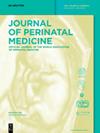在产前检查诊所就诊的孕妇中使用补充和替代药物:一个值得思考的问题
IF 1.4
4区 医学
Q3 OBSTETRICS & GYNECOLOGY
引用次数: 0
摘要
目标 补充和替代医学(CAM)是一组多样化的医疗和保健系统、实践和产品,一般不被视为传统医学的一部分。孕妇很容易受到药物的不良影响,尤其是在怀孕的前三个月。虽然建议孕妇在怀孕期间避免不必要的药物摄入,但 CAM 的使用非常普遍。方法 在印度拉贾斯坦邦南部乌代布尔地区的一家三级教学医院产前门诊中,对 120 名孕妇进行了横断面问卷调查。研究采用方便抽样策略,在 2022 年 7 月至 2023 年 12 月期间对年龄在 18 岁及以上的妇女进行了调查,并将数据输入经过预先测试和验证的问卷中。数据采用描述性统计方法进行分析,并采用卡方检验比较不同人口统计类别中使用 CAM 的情况,P 值小于 0.05 即为具有统计学意义。结果 在 120 名参与者中,有 58 人(48.33%)使用了 CAM疗法。在 58 名使用者中,有 44 人(75.86%)使用草药和amp;传统药物。有 20 人(34.48%)使用 CAM 来促进婴儿健康,18 人(31.03%)使用 CAM 来促进顺产,17 人(29.31%)使用 CAM 来提高免疫力。有 40 人(68.96%)是在亲戚/朋友的建议下开始使用 CAM 的。56 名(46.67%)参与者认为 CAM疗法不会对宫内胎儿造成不良影响,32 名(26.67%)参与者认为 CAM疗法和现代药物不会相互作用。结论 孕妇大量使用 CAM。有必要提高医护人员和孕妇对使用 CAM 可能产生的不良影响和药物间相互作用的认识。本文章由计算机程序翻译,如有差异,请以英文原文为准。
Complementary and alternative medicine use among pregnant women attending antenatal clinic: a point to ponder
Objectives Complementary and Alternative Medicine (CAM) is a group of diverse medical and healthcare systems, practices, and products that are not generally considered part of conventional medicine. Pregnant women are vulnerable to adverse effects of medicines, especially during the first trimester. Though it is advised to avoid unnecessary intake of medicine during pregnancy, CAM use is widespread. Methods A cross-sectional questionnaire-based study was conducted on 120 pregnant women attending the antenatal clinic of a tertiary-care teaching hospital in Udaipur district of Southern Rajasthan, India. Women of age 18 years and above were surveyed between July 2022 to December 2023 by convenient sampling strategy and data were entered in a pretested and pre-validated questionnaire. The data were analyzed using descriptive statistics, the Chi-square test was applied to compare CAM use among different demographic categories and a p-value less than 0.05 was considered statistically significant. Results Out of 120 participants, 58 (48.33 %) were using CAM therapy. Out of 58 users, 44 (75.86 %) were using herbal & traditional medicines. Twenty (34.48 %) were using CAM for a healthy baby, 18 (31.03 %) for easy delivery and 17 (29.31 %) for boosting immunity. Forty (68.96 %) participants started CAM on the advice of a relative/friend. Fifty six (46.67 %) participants believe that CAM therapy cannot cause adverse effects on the in utero child, while 32 (26.67 %) believe that CAM and modern medicines don’t interact. Conclusions CAM use among pregnant women is substantial. There is a need to raise awareness among the healthcare professionals and pregnant women regarding possible adverse effects and drug-drug interactions with CAM use.
求助全文
通过发布文献求助,成功后即可免费获取论文全文。
去求助
来源期刊

Journal of Perinatal Medicine
医学-妇产科学
CiteScore
4.40
自引率
8.30%
发文量
183
审稿时长
4-8 weeks
期刊介绍:
The Journal of Perinatal Medicine (JPM) is a truly international forum covering the entire field of perinatal medicine. It is an essential news source for all those obstetricians, neonatologists, perinatologists and allied health professionals who wish to keep abreast of progress in perinatal and related research. Ahead-of-print publishing ensures fastest possible knowledge transfer. The Journal provides statements on themes of topical interest as well as information and different views on controversial topics. It also informs about the academic, organisational and political aims and objectives of the World Association of Perinatal Medicine.
 求助内容:
求助内容: 应助结果提醒方式:
应助结果提醒方式:


